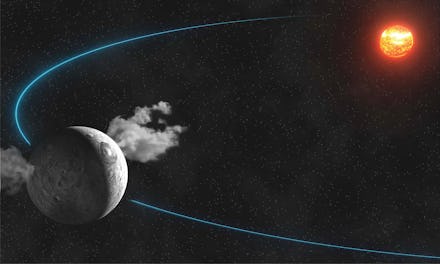Two Eerie Lights Are Shining from This Dwarf Planet — And No One Knows Why

Something strange has been detected deep in our solar system's asteroid belt, shining on a tiny piece of rock where no manmade spacecraft has ever been before.
NASA's Dawn spacecraft has photographed two bright, eerily beautiful lights on the dwarf planet Ceres, which orbits the sun between Mars and Jupiter from an average distance of 257 million miles.
Here's an image of the anomaly, courtesy of NASA's Jet Propulsion Laboratory:
The background: Dawn is actually on a mission to Ceres and the asteroid Vesta, and the spacecraft will approach the dwarf planet more closely within the next week. The photos of the mysterious lights were taken from a distance of 29,000 miles, too far to determine their cause.
Just 590 miles across, Ceres is the smallest dwarf planet ever discovered, but more interestingly, scientists suspect that its icy mantle could contain liquid subterranean oceans, according to Science. Since its peak surface temperature only reaches minus 37 degrees Fahrenheit, Space.com notes that it could possibly have a thin atmosphere formed from sublimated water. Aside from Earth and Mars, it is the only solar body whose surface has been observed to contain iron-rich clays.
Astronomers have yet to develop a satisfying explanation of why bright lights appear to be coming from its surface, and they may have to wait until Dawn is close enough to snap a clear photo showing the source of the anomaly.
What NASA thinks they might be: "The brightest spot continues to be too small to resolve with our camera, but despite its size it is brighter than anything else on Ceres. This is truly unexpected and still a mystery to us," lead investigator Andreas Nathues, of the Max Planck Institute For Solar System Research, said in a statement posted on NASA's website. In the same post, Dawn mission principal investigator Chris Russell added that "Ceres' bright spot can now be seen to have a companion of lesser brightness, but apparently in the same basin. This may be pointing to a volcano-like origin of the spots, but we will have to wait for better resolution before we can make such geologic interpretations."
Russell could be referring to Ceres' theorized ice volcanoes, which some propose eject pressurized water vapor rather than molten rock. The European Space Agency's Herschel infrared space telescope has previously detected plumes of water vapor coming off of the dwarf planet's surface, but it could also be the result of "cometary-style sublimation," according to Space.com. NASA reports that some scientists believe "when Ceres swings through the part of its orbit that is closer to the sun, a portion of its icy surface becomes warm enough to cause water vapor to escape in plumes at a rate of about 6 kilograms (13 pounds) per second."
A more mundane explanation, raised by Popular Mechanics, is that it the light could be reflecting off a gigantic patch of plain old salt, which could also be related to Ceres' ice geysers.
Then, of course, there's the more speculative conclusions:
With Dawn scheduled to arrive at Ceres shortly, this mystery is probably going to be solved much more quickly than other open astronomical questions, like whether Europa has underground oceans or if there was once life on Mars. Enjoy it while it lasts, space cadets.